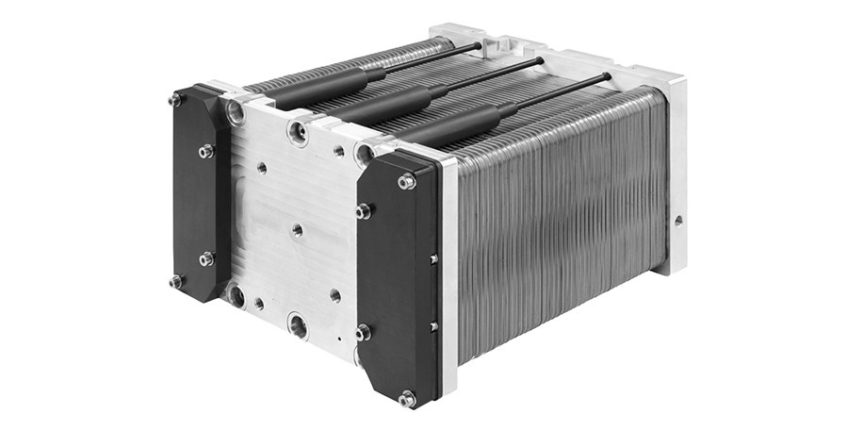In the FCM 5 project, a manufacturable PEM fuel cell module with processes suitable for mass production was developed. Aside from the NM5 stack based on metal bipolar plates in a power class of up to max. 20 kW, in addition an end plate media module assembly based on synthetic injection-moulded components was developed directly at the stack for the integration of system functions.
The project was able to demonstrate that the stacks could be made available in a nominal capacity between 3 kWel (18 cells, atmospheric operation) and 40 kWel (200 cells, pressure operation 2.5 bara). Meanwhile it has been proven that the NM5 stack with 260 cells and 60 kW can be optimally used.
NM5 key performance indicators:
Power density (pressure operation 2,5 bara):
- 7.5 kW/l (active areas)
- 6.6 kW/l (membrane areas used)
- 4.1 kW/l (cell stacks without end plates)
Power density (low pressure operation):
- 4.7 kW/l (active areas) scaled accordingly
Life cycle analyses in representative load cycles were carried out, which cover a typical operation window at atmospheric operation, except for explicit start/stop tests. The operating life was approx. 6,500 hours by the end of the project and was extended to more than 8,100 hours with degradation rates of under 6 μV per hour and cell, which corresponds to a power loss of significantly less than 10 per cent in 8,000 hours.
A new cell configuration which was tested in NM 5 individual cells, achieves a power density of 8.4 kW/l (pressure operation, see above), 7,8 kW/l and 4,8 kW/l respectively. Thus a stack with 400 cells has a power density of 3.6 kW/l.
In this new configuration, the NM5 stack format in particular fulfils the FCH JU (MAWP) performance goals of 1 W/cm² at a current density of 1.5 A/cm² in non-humidified operation.
The prestressing units were constructed on a synthetic/metal hybrid assembly basis and were qualified by means of experimental tests and FEM, where particularly the anticipated mechanical features had to be taken into account at advanced service life.
Within the media module, which is directly built onto on the end plate, are active and passive components like pressure and temperature sensors, valves, bypass tubes and droplet separators. The development of the function unit includes the fluid-technical construction of the subsystems with droplet separators as well as the provision of suitable sensors, which were developed in close cooperation with suppliers.
Synthetic end plates and a current collector assembly were also developed with a view to the cold start ability of the stack. In particular this ensured that the heat transfer between end plates and margin cells was very low. It was proven that a passive cold start as low as – 20°C is possible, without any heating of the stack components.
Stack and tension systems are designed for vibration and impact loads common in industrial applications. According to the provisions of the DIN EN 60068 Environmental influences Part 2 – 27 and Part 2 – 64 standard, the stack was subjected to a shock test at 25g and a vibration test with a noise spectrum of between 10 Hz and 1 kHz, with no function restrictions identified.
With the development of the NM5 stack format and the FCM 5 module, products will be made available that serve a broad field of application in industrial applications. The products can be used to great advantage in a capacity range from industrial trucks to light commercial vehicles.
Funding Code
03BI109
| Partner | Start of term | End of term | Funding amount |
| ElringKlinger AG | 01.09.11 | 30.06.16 | 3,461,679.57 € |
| 3,461,679.57 € |

